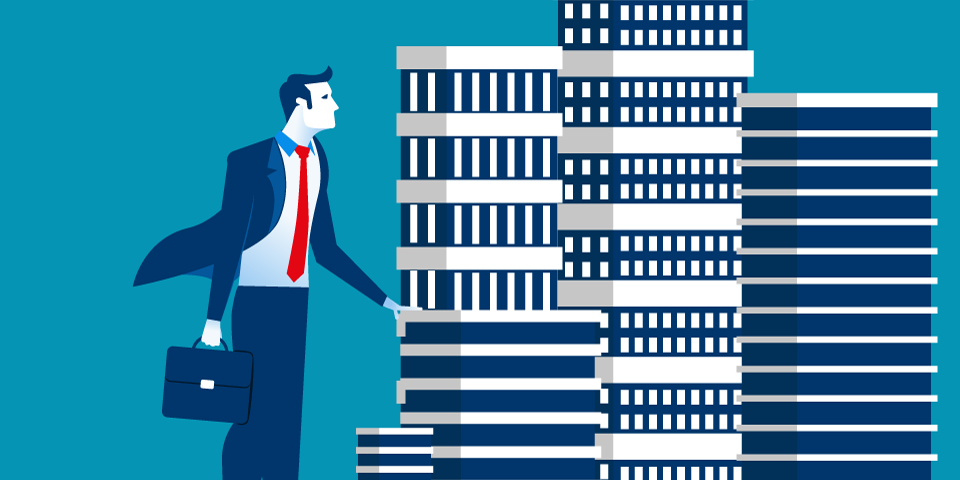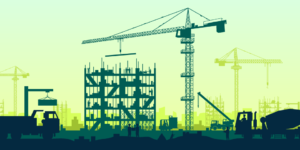The commercial real estate market has remained stagnant in the first half of the year, showing no growth but also no losses. Considering the significant headwinds the industry has faced over the last six months—from elevated interest rates to employment losses to tariffs—flat market growth is welcome news and a sign the industry is holding down these challenges. As CRE Daily said of the second quarter performance, “Flat isn’t flashy, but in today’s market, it’s a win.”
Overall, the second quarter has shown rising investment volume and flat prices, according to the MSCI Real Assets Index. Second quarter investment activity is expected to hit $120 billion, a nearly 30% annual increase in investment activity and well above the 8% forecast. Pricing, however, remained flat for the quarter, while average cap rates fell 25 basis points to 6.48%. Industrial and retail assets have led the market activity in the first half of the year, while apartment investment waned compared to last year and office growth is still stagnant.
Here is a closer look at the performance of each of the four major asset classes and where investors and developers can find the best opportunities in the second half of 2025.
Multifamily
Multifamily investment, which has helped to prop up commercial real estate activity in the last few years, took a pause in the second quarter of the year. Transaction volumes fell 46.1% year-over-year, the largest decrease in transaction volume among all commercial real estate asset classes. Construction activity has also significantly slowed. The new construction pipeline has fallen below 500,000 units under construction, and new starts are the lowest they have been since 2012. Weakening demand fundamentals are the impetus behind the waning investment and development activity. While apartment vacancy remains near its historical average—a significant achievement considering the record deliveries last year—demand softened in the second quarter alongside weakening consumer sentiment. At the same time, rent growth also slowed to 1.7% for the quarter, a deceleration of 50 basis points, according to Cushman & Wakefield. Affordable and workforce housing are one standout area of the multifamily market. These two apartment niches have shown resilience, and JPMorgan has spotlighted them as areas of opportunity this year and in 2026.
Office
The office market is a dynamic story. The asset class is continuing to evolve in response the abrupt change in demand born during the pandemic. Investors are beginning to show optimism. In the second quarter, transaction activity was up nearly 12%, likely due to falling prices and increased distressed assets. Demand fundamentals and new construction activity, on the other hand, continue to falter. National office vacancy climbed 90 basis points year-over-year in the second quarter to 20.8%, and sublease inventory grew to 1.6 million square feet, although still 10% below its peak in early 2024. As a result, new construction activity is a staggering 67% below the average in the 2010s. Still, there are signs of improvement. Most major metros posted more than 500,000 square feet of positive absorption activity, a sign that recovery is happening slowly.
Industrial
The industrial market has continued to exceed expectations in the face of significant headwinds, specifically tariffs and deteriorating consumer sentiment. Investors have not been deterred by the emerging risks. In the second quarter, investment volumes increased 15%, helping to drive overall gains in commercial real estate investment. Demand has also remained healthy. Year-to-date leasing activity is at 309 million square feet, on par with activity at the midyear 2024, and asking rents rose 2.6% year-over-year to $10.12 per square foot. There are signs of softening. Some markets are showing weakening fundamentals—particularly in the West, where both leasing activity and rents have fallen—and new construction activity is outpacing demand in the South and West regions. However, new construction activity has fallen nearly 45% year-over-year, showing that developers are quickly adjusting to market demand. Niches like cold storage and outdoor storage are providing the best investment and development opportunities in the second half of the year.
Retail
The retail market is facing a challenging environment driven by decreasing consumer sentiment. Today, retail sales continue to perform, with overall retail sales up 3.3% year-over-year, while non-store retail sales were up 8.3% and restaurant sales were up 5.3%. This activity helped drive a 37.4% increase in retail transaction activity in the second quarter. Still, the headwinds are beginning to show up in the metrics. The national retail vacancy rate increased to 5.8% in the second quarter, and asking rent growth slowed to 2.3%. While rent growth is still healthy, Cushman & Wakefield reports that it is well below the 4% rent growth the market enjoyed at the beginning of 2024. For the remainder of the year and into 2026, forecasts expect the market to slip with increasing store closures and reduced consumer spending putting upward pressure on the retail vacancy rate. However, barring a recession, Cushman & Wakefield research expects the market to weather the storm.
Investors and developers are bogged down measuring volatile metrics quarter-over-quarter, and while fundamentals remain healthy—an exciting trend considering the market stressors—anemic growth is still creating a challenging landscape for developers. This is when modern real estate development software leveraging predictive analytics, AI and automation really shine. By allowing machine learning to handle the heavy lifting on data analysis, developers can gain a clearer picture of the current market and a more accurate forecast of where activity is heading. Developers can then make informed decisions that best align with their investment targets. Then, automation steps in to manage budgets, spending, contracts and invoices to ensure the process stays on track throughout the project. Northspyre has delivered proven results to developers, supporting over $200 billion in projects across the US. As markets become more nuanced and complex, data-backed solutions are what the future of investment will look like.
Book a demo with Northspyre and learn how the end-to-end development platform can help you deliver more predictable outcomes and higher returns on complex projects.



